训练DETR
- 一、数据准备
- 二、配置DETR
- 三、绘图
- 四、推理
- 五、一些小bug
- References
一、数据准备
DETR用的是COCO格式的数据集。
如果要用DETR训练自己的数据集,直接利用Labelimg标注成COCO格式。
如果是VOC数据集的话,要做一个格式转换。网上一大堆格式转换的代码都很乱,所以自己写了一个针对VOC数据集的转换。
COCO数据集的格式类似这样,annotations文件夹里面有对应的train、val数据集的json文件。train2017则是训练集图片,其他同理。
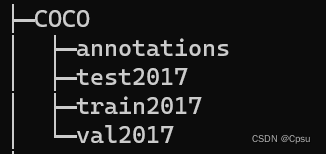
VOC数据集的存放方式是这样的,转换格式就是找出Main文件夹下用于目标检测的图片。
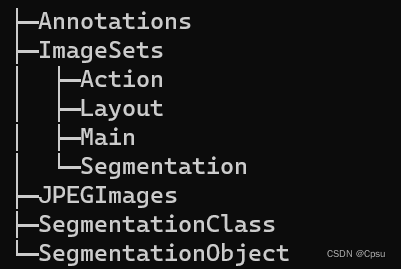
Main文件夹下有train.txt文件,记录了训练集的图片。val.txt记录了验证集的图片

只需要修改注释中的两个路径即可(创建文件夹时没有加判断语句严谨一点应该加上)。
import os
import shutil
import sys
import json
import glob
import xml.etree.ElementTree as ET
START_BOUNDING_BOX_ID = 1
# PRE_DEFINE_CATEGORIES = None
# If necessary, pre-define category and its id
PRE_DEFINE_CATEGORIES = {"aeroplane": 1, "bicycle": 2, "bird": 3, "boat": 4,
"bottle": 5, "bus": 6, "car": 7, "cat": 8, "chair": 9,
"cow": 10, "diningtable": 11, "dog": 12, "horse": 13,
"motorbike": 14, "person": 15, "pottedplant": 16,
"sheep": 17, "sofa": 18, "train": 19, "tvmonitor": 20}
def get(root, name):
vars = root.findall(name)
return vars
def get_and_check(root, name, length):
vars = root.findall(name)
if len(vars) == 0:
raise ValueError("Can not find %s in %s." % (name, root.tag))
if length > 0 and len(vars) != length:
raise ValueError(
"The size of %s is supposed to be %d, but is %d."
% (name, length, len(vars))
)
if length == 1:
vars = vars[0]
return vars
def get_filename_as_int(filename):
try:
filename = filename.replace("\\", "/")
filename = os.path.splitext(os.path.basename(filename))[0]
return int(filename)
except:
raise ValueError(
"Filename %s is supposed to be an integer." % (filename))
def get_categories(xml_files):
"""Generate category name to id mapping from a list of xml files.
Arguments:
xml_files {list} -- A list of xml file paths.
Returns:
dict -- category name to id mapping.
"""
classes_names = []
for xml_file in xml_files:
tree = ET.parse(xml_file)
root = tree.getroot()
for member in root.findall("object"):
classes_names.append(member[0].text)
classes_names = list(set(classes_names))
classes_names.sort()
return {name: i for i, name in enumerate(classes_names)}
def convert(xml_files, json_file):
json_dict = {"images": [], "type": "instances",
"annotations": [], "categories": []}
if PRE_DEFINE_CATEGORIES is not None:
categories = PRE_DEFINE_CATEGORIES
else:
categories = get_categories(xml_files)
bnd_id = START_BOUNDING_BOX_ID
for xml_file in xml_files:
tree = ET.parse(xml_file)
root = tree.getroot()
path = get(root, "path")
if len(path) == 1:
filename = os.path.basename(path[0].text)
elif len(path) == 0:
filename = get_and_check(root, "filename", 1).text
else:
raise ValueError("%d paths found in %s" % (len(path), xml_file))
# The filename must be a number
image_id = get_filename_as_int(filename)
size = get_and_check(root, "size", 1)
width = int(get_and_check(size, "width", 1).text)
height = int(get_and_check(size, "height", 1).text)
image = {
"file_name": filename,
"height": height,
"width": width,
"id": image_id,
}
json_dict["images"].append(image)
# Currently we do not support segmentation.
# segmented = get_and_check(root, 'segmented', 1).text
# assert segmented == '0'
for obj in get(root, "object"):
category = get_and_check(obj, "name", 1).text
if category not in categories:
new_id = len(categories)
categories[category] = new_id
category_id = categories[category]
bndbox = get_and_check(obj, "bndbox", 1)
xmin = int(get_and_check(bndbox, "xmin", 1).text) - 1
ymin = int(get_and_check(bndbox, "ymin", 1).text) - 1
xmax = int(get_and_check(bndbox, "xmax", 1).text)
ymax = int(get_and_check(bndbox, "ymax", 1).text)
assert xmax > xmin
assert ymax > ymin
o_width = abs(xmax - xmin)
o_height = abs(ymax - ymin)
ann = {
"area": o_width * o_height,
"iscrowd": 0,
"image_id": image_id,
"bbox": [xmin, ymin, o_width, o_height],
"category_id": category_id,
"id": bnd_id,
"ignore": 0,
"segmentation": [],
}
json_dict["annotations"].append(ann)
bnd_id = bnd_id + 1
for cate, cid in categories.items():
cat = {"supercategory": "none", "id": cid, "name": cate}
json_dict["categories"].append(cat)
os.makedirs(os.path.dirname(json_file), exist_ok=True)
json_fp = open(json_file, "w")
json_str = json.dumps(json_dict)
json_fp.write(json_str)
json_fp.close()
if __name__ == "__main__":
# 只需修改以下两个路径
# VOC数据集根目录
voc_path = "VOC2012"
# 保存coco格式数据集根目录
save_coco_path = "VOC2COCO"
# VOC只分了训练集和验证集即train.txt和val.txt
data_type_list = ["train", "val"]
for data_type in data_type_list:
os.makedirs(os.path.join(save_coco_path, data_type+"2017"))
os.makedirs(os.path.join(save_coco_path, data_type+"_xml"))
with open(os.path.join(voc_path, "ImageSets\Main", data_type+".txt"), "r") as f:
txt_ls = f.readlines()
txt_ls = [i.strip() for i in txt_ls]
for i in os.listdir(os.path.join(voc_path, "JPEGImages")):
if os.path.splitext(i)[0] in txt_ls:
shutil.copy(os.path.join(voc_path, "JPEGImages", i),
os.path.join(save_coco_path, data_type+"2017", i))
shutil.copy(os.path.join(voc_path, "Annotations", i[:-4]+".xml"), os.path.join(
save_coco_path, data_type+"_xml", i[:-4]+".xml"))
xml_path = os.path.join(save_coco_path, data_type+"_xml")
xml_files = glob.glob(os.path.join(xml_path, "*.xml"))
convert(xml_files, os.path.join(save_coco_path,
"annotations", "instances_"+data_type+"2017.json"))
shutil.rmtree(xml_path)
结果如图所示,在voc2coco文件夹下有三个文件:
二、配置DETR
修改main.py文件中的参数、超参数:

这个最好不改,就设为coco。去修改models/detr.py 文件的num_classes(大概在三百多行)。这里作者也解释了num_classes其实并不是类别数,因为coco只有80类,因为coco的id是不连续的,coco数据集最大的ID是90,所以原论文时写的MAX ID +1 即91。对于我们自定义的和转化的VOC数据集num_classes就是类别数。
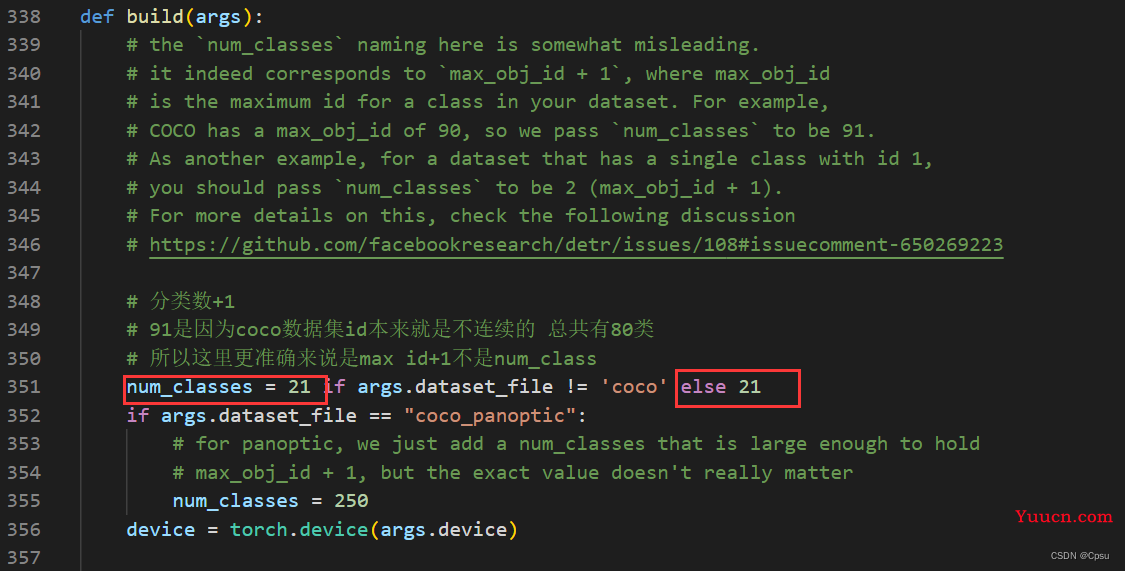
![]()
coco_path改成自己的coco路径。

其中预训练权重需要修改一下,coco是80类,不能直接加载官方的模型。voc是20类。把num_classes改成21。传入得到的detr_r50_21.pth新的权重文件。
import torch
pretrained_weights=torch.load('detr-r50-e632da11.pth')
num_classes=21
pretrained_weights["model"]["class_embed.weight"].resize_(num_classes+1,256)
pretrained_weights["model"]["class_embed.bias"].resize_(num_classes+1)
torch.save(pretrained_weights,"detr_r50_%d.path"%num_classes)
运行日志(特别难训练):

三、绘图
在util文件夹下有plot_utils.py文件,可以绘制损失和mAP曲线。
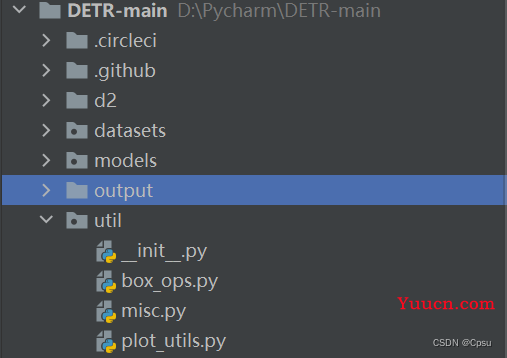
在plot_utils.py文件中加入代码运行即可:
if __name__ == "__main__":
# 路径更换为保存输出的eval路径
# mAP曲线
files=list(Path("./outputs/eval").glob("*.pth"))
plot_precision_recall(files)
plt.show()
# 路径更换为保存输出的路径
# 损失曲线
plot_logs(Path("./output"))
plt.show()
四、推理
训练完毕后我们会得到一个checkpoint.pth的文件,可以用自己训练得到的模型来推理图片,代码如下:
import argparse
import numpy as np
from models.detr import DETR
from models.backbone import Backbone, build_backbone
from models.transformer import build_transformer
from PIL import Image
import cv2
import matplotlib.pyplot as plt
import torch
import torchvision.transforms as T
torch.set_grad_enabled(False)
def get_args_parser():
parser = argparse.ArgumentParser('Set transformer detector', add_help=False)
parser.add_argument('--lr', default=1e-4, type=float)
parser.add_argument('--lr_backbone', default=1e-5, type=float)
parser.add_argument('--batch_size', default=2, type=int)
parser.add_argument('--weight_decay', default=1e-4, type=float)
parser.add_argument('--epochs', default=300, type=int)
parser.add_argument('--lr_drop', default=200, type=int)
parser.add_argument('--clip_max_norm', default=0.1, type=float,
help='gradient clipping max norm')
# Model parameters
parser.add_argument('--frozen_weights', type=str, default=None,
help="Path to the pretrained model. If set, only the mask head will be trained")
# * Backbone
parser.add_argument('--backbone', default='resnet50', type=str,
help="Name of the convolutional backbone to use")
parser.add_argument('--dilation', action='store_true',
help="If true, we replace stride with dilation in the last convolutional block (DC5)")
parser.add_argument('--position_embedding', default='sine', type=str, choices=('sine', 'learned'),
help="Type of positional embedding to use on top of the image features")
# * Transformer
parser.add_argument('--enc_layers', default=6, type=int,
help="Number of encoding layers in the transformer")
parser.add_argument('--dec_layers', default=6, type=int,
help="Number of decoding layers in the transformer")
parser.add_argument('--dim_feedforward', default=2048, type=int,
help="Intermediate size of the feedforward layers in the transformer blocks")
parser.add_argument('--hidden_dim', default=256, type=int,
help="Size of the embeddings (dimension of the transformer)")
parser.add_argument('--dropout', default=0.1, type=float,
help="Dropout applied in the transformer")
parser.add_argument('--nheads', default=8, type=int,
help="Number of attention heads inside the transformer's attentions")
parser.add_argument('--num_queries', default=100, type=int,
help="Number of query slots")
parser.add_argument('--pre_norm', action='store_true')
# * Segmentation
parser.add_argument('--masks', action='store_true',
help="Train segmentation head if the flag is provided")
# Loss
parser.add_argument('--no_aux_loss', dest='aux_loss', action='store_false',
help="Disables auxiliary decoding losses (loss at each layer)")
# * Matcher
parser.add_argument('--set_cost_class', default=1, type=float,
help="Class coefficient in the matching cost")
parser.add_argument('--set_cost_bbox', default=5, type=float,
help="L1 box coefficient in the matching cost")
parser.add_argument('--set_cost_giou', default=2, type=float,
help="giou box coefficient in the matching cost")
# * Loss coefficients
parser.add_argument('--mask_loss_coef', default=1, type=float)
parser.add_argument('--dice_loss_coef', default=1, type=float)
parser.add_argument('--bbox_loss_coef', default=5, type=float)
parser.add_argument('--giou_loss_coef', default=2, type=float)
parser.add_argument('--eos_coef', default=0.1, type=float,
help="Relative classification weight of the no-object class")
# dataset parameters
parser.add_argument('--dataset_file', default='coco')
parser.add_argument('--coco_path', type=str, default=r"F:\DLdata\VOC2COCO")
parser.add_argument('--coco_panoptic_path', type=str)
parser.add_argument('--remove_difficult', action='store_true')
parser.add_argument('--output_dir', default='./output',
help='path where to save, empty for no saving')
parser.add_argument('--device', default='cuda',
help='device to use for training / testing')
parser.add_argument('--seed', default=42, type=int)
parser.add_argument('--resume', default='detr_r50_21.path', help='resume from checkpoint')
# parser.add_argument('--resume', default='detr-r50-e632da11.pth', help='resume from checkpoint')
parser.add_argument('--start_epoch', default=0, type=int, metavar='N',
help='start epoch')
parser.add_argument('--eval', action='store_true')
parser.add_argument('--num_workers', default=0, type=int)
# distributed training parameters
parser.add_argument('--world_size', default=1, type=int,
help='number of distributed processes')
parser.add_argument('--dist_url', default='env://', help='url used to set up distributed training')
return parser
COLORS = [[0.000, 0.447, 0.741], [0.850, 0.325, 0.098], [0.929, 0.694, 0.125], [0.494, 0.184, 0.556],
[0.466, 0.674, 0.188], [0.301, 0.745, 0.933]]
transform_input = T.Compose([T.Resize(800),
T.ToTensor(),
T.Normalize([0.485, 0.456, 0.406], [0.229, 0.224, 0.225])])
def box_cxcywh_to_xyxy(x):
x_c, y_c, w, h = x.unbind(1)
b = [(x_c - 0.5 * w), (y_c - 0.5 * h),
(x_c + 0.5 * w), (y_c + 0.5 * h)]
return torch.stack(b, dim=1)
def rescale_bboxes(out_bbox, size):
img_w, img_h = size
b = box_cxcywh_to_xyxy(out_bbox)
b = b * torch.tensor([img_w, img_h, img_w, img_h], dtype=torch.float32, device="cuda")
return b
def plot_results(pil_img, prob, boxes, img_save_path):
plt.figure(figsize=(16, 10))
plt.imshow(pil_img)
ax = plt.gca()
colors = COLORS * 100
for p, (xmin, ymin, xmax, ymax), c in zip(prob, boxes.tolist(), colors):
ax.add_patch(plt.Rectangle((xmin, ymin), xmax - xmin, ymax - ymin,
fill=False, color=c, linewidth=3))
cl = p.argmax()
text = f'{CLASSES[cl]}: {p[cl]:0.2f}'
ax.text(xmin, ymin, text, fontsize=9,
bbox=dict(facecolor='yellow', alpha=0.5))
plt.savefig(img_save_path)
plt.axis('off')
plt.show()
def main(num_classes, chenkpoint_path, img_path, img_save_path, num_queries=100):
parser = argparse.ArgumentParser('DETR training and evaluation script', parents=[get_args_parser()])
args = parser.parse_args()
backbone = build_backbone(args)
transform = build_transformer(args)
model = DETR(backbone=backbone, transformer=transform, num_classes=num_classes, num_queries=100)
device = "cuda" if torch.cuda.is_available() else "cpu"
model.to(device)
model_path = chenkpoint_path
model_data = torch.load(model_path)['model']
model.load_state_dict(model_data)
model.eval()
path = img_path
im = cv2.imread(path)
im = Image.fromarray(cv2.cvtColor(im, cv2.COLOR_BGR2RGB))
img = transform_input(im).unsqueeze(0)
outputs = model(img.to(device))
probs = outputs['pred_logits'].softmax(-1)[0, :, :-1]
# 可修改阈值,只输出概率大于0.7的物体
keep = probs.max(-1).values > 0.7
# print(probs[keep])
bboxes_scaled = rescale_bboxes(outputs['pred_boxes'][0, keep], im.size)
ori_img = np.array(im)
plot_results(ori_img, probs[keep], bboxes_scaled, img_save_path)
if __name__ == "__main__":
CLASSES = ['N/A', "aeroplane", "bicycle", "bird", "boat",
"bottle", "bus", "car", "cat", "chair",
"cow", "diningtable", "dog", "horse",
"motorbike", "person", "pottedplant",
"sheep", "sofa", "train", "tvmonitor"]
main(num_classes=21, chenkpoint_path="checkpoint.pth", img_path="test.png",
img_save_path="result2.png")
几点说明:
1.CLASSES是我们数据集对应的类别名,注意自己标注的顺序一定写对。第一个类别是背景类,这个是固定的,所有数据集都要有。
2.
num_classes:类别数+1
chenkpoint_path:保存的权重文件
img_path:测试的图片路径
img_save_path:保存结果路径
3.可修改阈值,论文中默认只输出概率大于0.7的物体。
用VOC数据集训练的模型推理效果:
(VOC数据集中没有自行车一类所以识别不出来)
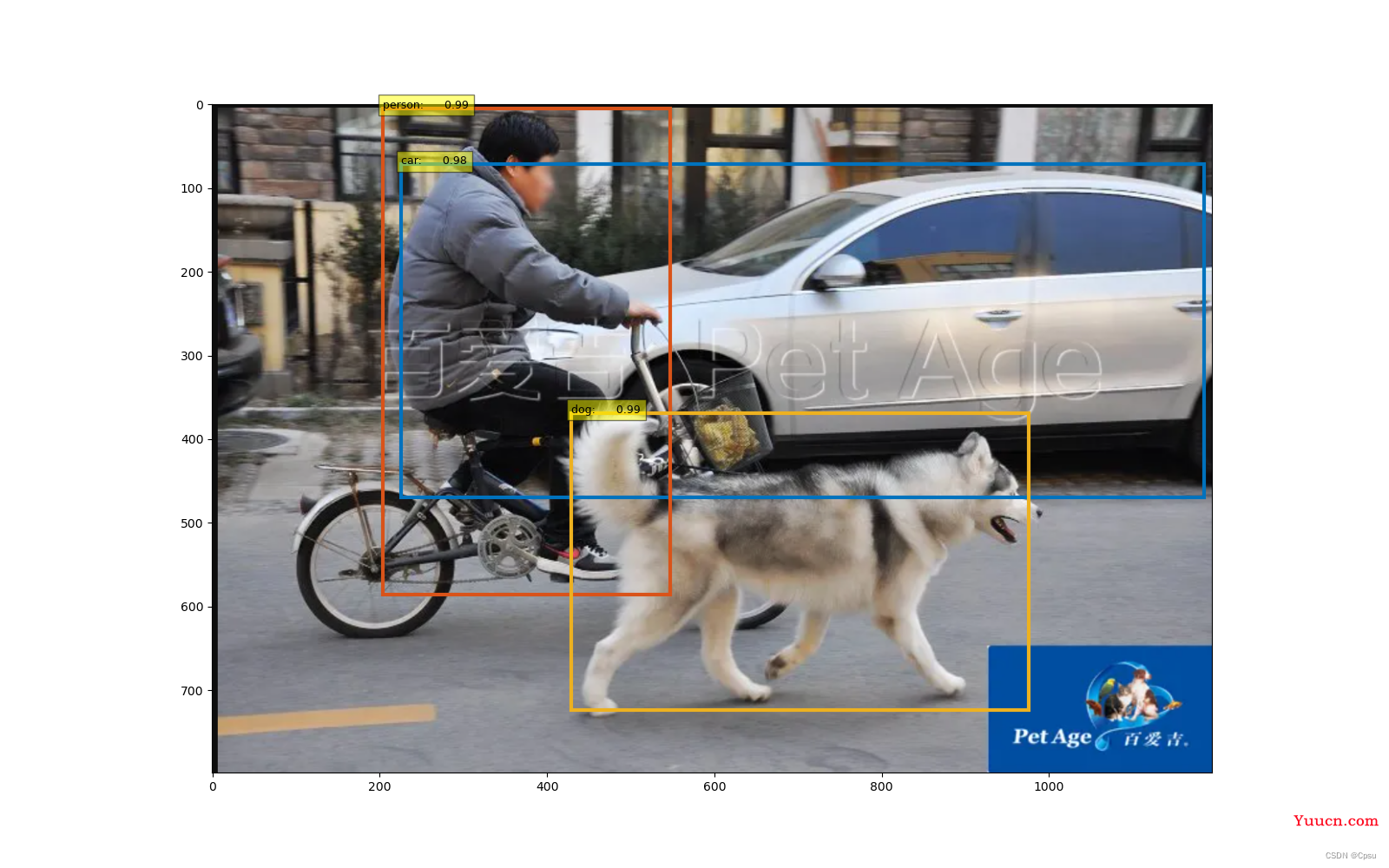
五、一些小bug
UserWarning: floordiv is deprecated, and its behavior will change in a future version of pytorch. It currently rounds toward 0 (like the ‘trunc’ function NOT ‘floor’). This results in incorrect rounding for negative values. To keep the current behavior, use torch.div(a, b, rounding_mode=‘trunc’), or for actual floor division, use torch.div(a, b, rounding_mode=‘floor’).
这时一个torch版本原因导致的一个函数问题,报了一个警告。
将models/position_encoding.py文件中的第44行改成如下形式即可。
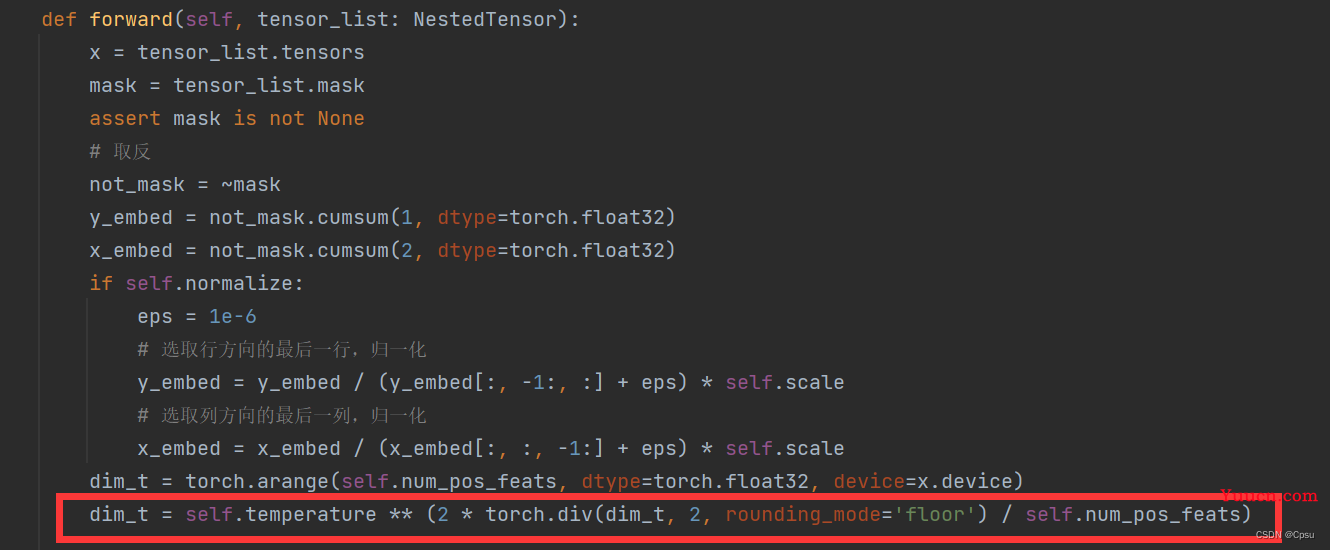
References
VOC2COCO代码参考Github
DETR预训练模型